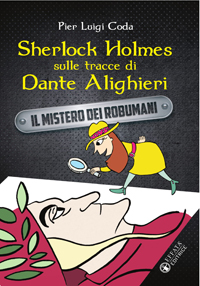 |
Sherlock Holmes on the traces of Dante Alighieri
The mystery of the robumans
(Effatà Editrice - Cantalupa Torino)
Drowings byi Silvia Aimar
Graphics by Silvia Aimar and Vito Mosca |
| The birth of the story |
This story is dedicated to my wife Vittoria because everything was born in Florence |
.jpg)
James Joyce |
During an interview with a US biographer, James Joyce declared that he "loved Dante almost like the Bible. He is my spiritual food. The rest is just ballast ". That's right, in no uncertain terms, Joyce used the word "ballast". But we cannot forget the affection, I would say almost the devotion, of two great popes towards Dante Alighieri: Pope Benedict XV and, closer to our days, Pope Francis. Benedict XV, in the letter "In Praeclara Summorum" of 1921, addressed to boys and teachers, wrote as follows: "Love this Poet that We do not hesitate to define the most eloquent singer and herald of Christian thought". And Pope Francis adds: "Dante is a prophet of hope, a herald of the possibility of redemption, of liberation, of the profound change of every man and woman, of all humanity".
|
I believe that these considerations can also be shared by those of Dante who only observe the literary or historical aspect, but to diminish the transcendence and the weight of transcendence in Dante's work, in my opinion, constitutes a true mutilation of his poetic grandeur . Not even William Blake has escaped this temptation, although his illustrations of the Divine Comedy are memorable artistic masterpieces. However one turns it, Dante, for centuries, has inspired images and beauty, boundless dreams and sudden awakenings; to me Dante has always appeared as an immense monument, unapproachable as a dolomitic rock. The mere thought of being able to write something about him seemed an affront to his greatness. Instead, sometimes things get out of hand, strange coincidences are enough or, perhaps, just a nudge from the case.
|
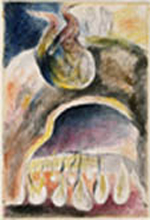
William Blake -Ulysses
|
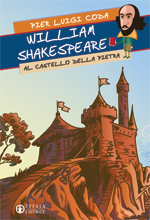
William Shekespeare at the Stone Castle
Effatà Publisher
|
In fact, during the recent meetings with the schools, some teachers suggested I write a text that brings the interest of the children towards Dante Alighieri closer, as I did for Shakespeare in the story "William Shakespeare at the Castle of the Stone". At the time I considered this proposal hardly feasible; issues too complex, certainly fascinating but, perhaps, too far away for a captivating narrative of actuality. |
True, even Shakespeare, in terms of the universality of thought, does not joke and has managed to climb over the highest and steep peaks of the intellect and of the word, but it was not complicated for me to transfer the scenographic theatricality of his art into a story, a sort of mystery thriller, for young readers.
|

William Shakespeare
|
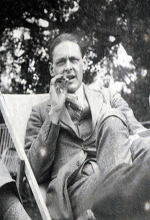
Thomas Stearns Eliot
|
But the spark had been lit, the words of Thomas Stearns Eliot, Nobel Prize for literature and author of the beautiful "Ash Wednesday" and of "Assassination in the cathedral:" Dante and Shakespeare share the modern world; there is not a third one ”. I don't know, who knows ...
|
The fact is that Dante, with his always frowning face and leaning nose, continued to tease my thoughts and continued to re-emerge the love I always felt for man and his poetry; a long-standing love, born on the benches of the Liceo Scientifico of Imperia when it was located in Piazza del Duomo and had not yet been registered to Vieusseux. |
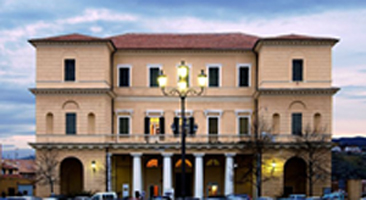 The old LiceoScientifico in Imperia
The old LiceoScientifico in Imperia |
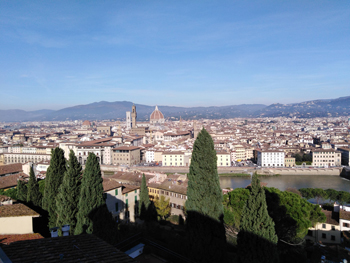
Florence
|
And then, in the background, it always reappeared Florence, my wife's Tuscany, the months I spent at the National Library preparing my thesis, during a hot summer that dried up the Arno waters. The days passed at Palazzo Pitti, the Uffizi, and the Bargello reappeared to discuss with my father-in-law about Fattori, Soffici, Lega and Sernesi.
|
And Dante had walked those same streets, the same tangle of streets, the Ponte Vecchio, the beautiful San Giovanni, the church of Santa Margherita where, perhaps, he had met Beatrice for the first time and, in any case, he had married Gemma Donati there. One of the most surprising and grandiose journeys in history had departed from these stones and these boroughs. A winding and difficult path through the mysterious meanders of life where courage and fear intertwine, love and hate, defeats, triumphs and often the bitter morsels of unbearable humiliation. But if the look is curved and frowning, the thought frees itself high above the clouds and reaches, between falls and obstinate ascents, the embrace of the shining Light that governs illuminating the Universe.
|
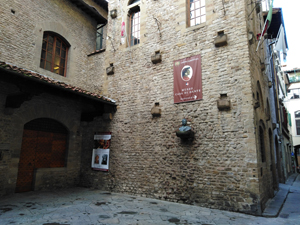 Florence - Dante's birthplace
Florence - Dante's birthplace
|
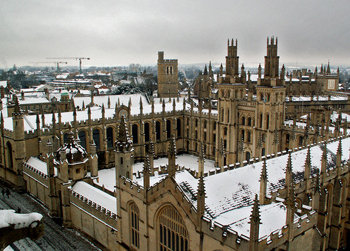 All Souls College - Oxford
All Souls College - Oxford |
If these were the themes, the narrative problem was how to convey them to young readers. How can you accompany them, without yawning, along the paths of the Vita Nova, the Comedy, the Convivium and the Epistles? And then can we still speak of transcendence? I remember that in the years I lived in Oxford, one afternoon I was wandering through the gardens of "All Souls " one of the many famous colleges that made the city famous. At a certain point I had a large school of teenagers walking by, accompanied by their teacher, who asked if they knew the meaning of "Soul", no one answered; shyness? ignorance? I don't know, I never understood it but I was deeply disturbed, as a believer and as a writer. Is there space today for the supernatural? Can we talk about it to boys and girls? And if we talk about it, do we hurt someone's sensitivity? |
These concerns have accompanied the writing of the story "Sherlock Holmes on the trail of Dante Alighieri - The mystery of the robumansi", a science fiction detective in which a famous detective tries to solve the case of strange art thefts inspired by the works of Dante. To solve the worrying case, a team of terrible boys will help and the usual chief inspector a bit bumbling and clumsy. Here and there in the story, beyond the centrality of Dante's thought, other issues emerge such as solidarity, attention to disability, the formative function of sport, a pinch of art and interactive involvement. |
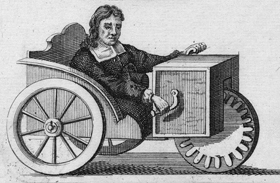 First self-propelled wheelchair invented by Stephan Farfler in 1655
First self-propelled wheelchair invented by Stephan Farfler in 1655
|
|

